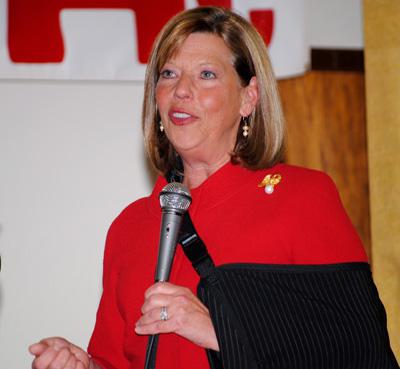Political Blogs
A New Era of Responsibility
August 26th 2011 by News

Questions are swirling about the cuts Congress and the president have pledged to make as we begin the process of getting our federal budget under control. While the size and scope of the cuts has been agreed to in a framework that outlines $2.4 trillion in savings, the details have yet to emerge. On one hand, we should be confident that these cuts are possible. After all, I wrote a bill to cut spending on the U.S. Treasury, Internal Revenue Service, and a few dozen federal agencies by nearly ten percent over last year, which reflected further cuts. That bill and other legislation taking similar steps form a solid basis for the cuts which are reflected in the new framework. They include lots of specifics.
But on the other hand, there is no guarantee that the proposals to actually achieve these much-needed savings will be so specific. The framework is vague, and the cuts included in it represent only the first few steps on a long road to fiscal security for our nation. Washington bureaucrats have a long and storied history of saying one thing and doing quite the opposite, especially when it comes to spending.
The most egregious example is a recent one. The title of President Obama’s first budget for FY 2010 was this: A New Era of Responsibility. For that budget year, the federal government spent $4.472 trillion – more than $740 billion than in the year prior. The Government Accountability Office found $125 billion in waste, fraud and abuse in its audit of that year alone. Our country ran a total deficit of $1.17 trillion.
It was more like A New Era of Irresponsibility. The deficits would continue. For FY 2011, the most recent estimates place our federal deficit at $1.65 trillion. For FY 2012, the federal deficit is expected to exceed $1.1 trillion – and in 2009, the first year of the Obama Administration, a projected deficit of $407 billion became an actual deficit of $1.4 trillion. From 2009 to 2012, our nation will shoulder $5.32 trillion in new debt.
There are two arguments in our nation’s capital. The first is whether we should stop this pattern of deficit spending and the second is how we should stop it. Our debt is a speeding train, and it will take decades to resolve. But one thing is clear to the American people: we cannot afford to take this matter lightly, and we cannot take our federal budgets at face value.
In the weeks and months ahead, I hope we will hear plans. I am even more hopeful that we will hear specifics. I’m bringing my own ideas to the table. In addition to the billions I propose saving at the subcommittee I chair on Financial Services Appropriations, I think the federal government ought to save billions on prescription drugs, reform our tax code by making it flatter and fairer, and save billions by closing the loopholes that enable others to defraud, cheat and take advantage of our system of government and our way of life.
When someone else doesn’t pay their taxes, you end up paying for them. When someone else uses a stolen identity to get a Social Security check they don’t deserve, benefits are less secure for everyone who plays by the rules. A New Era of Responsibility means we take on the challenges of federal excesses while keeping our promises to all Americans who believe in our nation and want it to endure.
Jo Ann Emerson of Cape Girardeau represents the Eighth District of Missouri in the U.S. House of Representatives.
Last Updated on August 26th 2011 by News
https://showmetimes.com/Blogpost/uk0n/A-New-Era-of-Responsibility
The VA In The Modern Era
August 19th 2011 by News

The Veterans Administration has a mission unlike that of any other federal agency. Put simply, they are charged with keeping the promise America makes to the men and women who serve in uniform. They and their families enter into an agreement with our country: you take care of us, and we will take care of you.
That simple agreement is not always easy to keep for a federal agency notorious for unacceptable backlogs, difficult health care policies, and even lapses in the safe practice of medicine. Yet despite these problems, the VA has many dedicated professionals (benefits counselors, medical technicians, nurses, doctors, claims agents and case managers) who work very hard to serve the brave Americans who have served our country.
And in Congress, where it seems you can find two people who will argue until they are blue in the face about anything at all, no one disputes the importance of the VA and the care and benefits it provides. Finding funding for the VA, even in a difficult budget environment like this one, is something that Republicans and Democrats can agree is important.
I talk to a lot of veterans in Southern Missouri about their VA concerns. Some have casework that needs to be addressed: their benefits have been delayed in processing for too long, they have a service-connected condition that needs the attention of a specialist, or they just need help with the paperwork. All the cases have one thing in common, however: a desire for the VA to work faster, to be more efficient, and to provide better information to our veterans and their families.
When a claim is delayed or when a doctor is too far away, it is the veteran who pays the price. He or she must wait, must sift through papers, must sit on hold while someone works to resolve their problem. Even then, the answer is not always satisfactory. I do not doubt the good intentions of the staff and providers at the VA, I just think they have to find new and better ways to cut through the red tape. Money alone won’t solve these problems at the VA.
As I have said many times before, the VA needs a change in culture to dramatically reduce its backlogs and to give veterans the quality care they deserve. And the challenges will continue to mount. Battlefield injuries are changing as war and weaponry changes. Soldiers who would have died on the field of battle 60 years ago are today making it to a field hospital. Their lives are saved by their fellow soldiers with modern medicine. Still, when they return home, they need a significant amount of care, rehabilitation, follow-up and monitoring to help them get on with their lives.
For young veterans, it is especially important that the VA works to stay in touch with them, to deliver information frequently and clearly. One indication that the culture at the VA is changing in this one aspect is this month’s issuance of a social media policy. The VA has more than 100 pages on Facebook, more than 50 Twitter feeds, two blogs, a YouTube channel and a Flickr page, according to a recent article in Information Week. It is good to see the VA embracing the modern era in this respect and trying harder to stay in contact with the veterans who need their services today more than ever.
Jo Ann Emerson of Cape Girardeau represents the Eighth District of Missouri in the U.S. House of Representatives.
Last Updated on August 19th 2011 by News
https://showmetimes.com/Blogpost/ujum/The-VA-In-The-Modern-Era
Fighting For Our Post Offices
August 12th 2011 by News

The U.S. Postal Service is a fundamental part of life in America – and especially in rural America. Unlike our counterparts in urban areas, Americans in rural places like Southern Missouri rely on the Postal Service to deliver prescription drugs, retail shipments, business mail and even bills to a greater extent than in the city. In fact, the newspaper you read regularly is probably delivered by the mail carrier.
It is very concerning, then, that the USPS is attempting to close thousands of Post Offices across the country, many of them in rural areas. Citing a financial shortfall of $3.1 billion in the second quarter of the year, the USPS says closing rural Post Offices will save them money. But at a cost of hundreds of thousands of customers, the last thing the Postal Service should do to save money is reduce its services.
Organizational changes to the Postal Service are sorely needed at an organization which lost a staggering $3.1 billion last quarter. For an historic part of American history and culture, the Postal Service is in dire straits. It is all the more striking, then, that the only solutions it is putting forward to save itself require sacrifices by either its customers or our taxpayers.
The Postal Service relies almost entirely on income from its business with customers. Only a tiny fraction of its funding comes from the federal government today. And, like every other business in America, the Postal Service must find ways to increase receipts by better serving its customers.
Reducing home delivery by one or more days strikes at the heart of the regularity and reliability the Postal Service once enjoyed as its undisputed image. Closing rural post offices hits customers in Southern Missouri with a double whammy: a letter carrier no longer comes to our door, and the box we must now buy if we want Saturday delivery is located at a Post Office in another town 30 miles from home. Alone, either of these options results in inconvenience and hardship for postal customers as well as lost business and foregone revenue for the Postal Service.
Greater efficiencies are possible, to be sure, in continuing to serve the public.
Recently, the Postal Service decided that mail at our rural post offices for local addresses can no longer be sorted, postmarked and routed there. Once upon a time, the postmaster in a small Southern Missouri town sees a birthday card from one resident to his neighbor next door, cancels the stamp and puts it in that neighbors’ slot for delivery the next day. Under the Postal Service’s new way of doing things, the postmaster sees the same birthday card, stuffs it into a sack with all the other outgoing mail collected that day, ships it to Kansas City or St. Louis where it is sorted, gets it back one or two days later, and puts it in the next day’s delivery. Now let me ask you: if you were running the Postal Service, what would you do?
Here is the journey a letter must make under the Postal Service’s proposed revisions to our system. Since there is no Post Office in your town anymore, you drive 30 miles to mail a first class letter to your niece on Wednesday, the package gets shipped to a sorting facility 140 miles away overnight, sorted and assigned and delivered to the next Post Office on Friday for Saturday delivery. But, wait, they’ve done away with Saturday delivery, so the delivery will have to wait until Monday, which is a federal holiday. Whoops. Your letter will be in your niece’s mailbox on Tuesday, seven days from point to point and considerable trouble on your part.
This is no way for the Postal Service to do business, and many of their customers will turn to email or telephone calls. For deliveries with no electronic alternatives, like mail-order pharmacy, there will be anger and stress and more than a few missed deadlines.
Our Post Offices and our letter carriers are valuable, important parts of our communities. They are suffering from poor management and a lack of leadership by USPS officials who cannot grasp the mission of their business – or its bottom line. Saving the Postal Service must begin with them, and soon.
Jo Ann Emerson of Cape Girardeau represents the Eighth District of Missouri in the U.S. House of Representatives.
Last Updated on August 12th 2011 by News
https://showmetimes.com/Blogpost/ujq4/Fighting-For-Our-Post-Offices
The Framework Is The Easy Part
August 05th 2011 by Unknown

The House of Representatives arrived at an historic agreement last week to cut $2.3 trillion in spending from the federal bureaucracy. It’s historic for reasons positive and for reasons not as great.
First, the good news: The legislation marks the very first time the authority of the Treasury to borrow money has been accompanied by budget cuts. This agreement cuts spending by an amount greater than it increases borrowing. Social Security and Medicare benefits are preserved intact for the Americans enrolled in the programs today and near retirement age. No tax increases of any kind are in the legislation.
The worthy idea of cutting our deficits is not new, but it is the first time the thought has been truly put into practice. In that regard, the tone in Washington is changing from how fast the administration can spend taxpayer money to a requirement that we slow the rate of deficit spending that threatens to bury our children and grandchildren beneath a mountain of debt. Our freedom stems from our sovereignty, and our sovereignty depends on responsible levels of spending and debt.
The framework put in place last week will drive down debt in the long term, requiring less borrowing. It will put future Americans in a position to create opportunities through innovation, ingenuity and hard work. It will offer less of our sovereign debt up for auction where it can be purchased by foreign powers. All those things are good.
Here is the bad news: The framework is the easy part. Now a select committee of legislators must get down to the details of the federal budget – more than $3 trillion next year alone, and start to find cuts that will get us to the $2.3 trillion goal over ten years. When a plan is complete to achieve these savings, the House and the Senate will vote again.
The bipartisan panel of six Senators and six Representatives will give Congress a chance to vote upon $1.4 trillion in cuts. It will be no easy task to arrive at a package which can both pass a Democratic Senate and a Republican House, but the consequences of not doing so will be really tough. Just as difficult will be the task of standing firm against special interests bent on preserving their favorite programs from reductions. We need major changes made quickly, and well-heeled lobbies in the capital will be working overtime to try to avoid sharing the pain.
What all Americans should keep in mind is that cutting government sounds good in principle, but it can be difficult in practice. The committee may propose cuts to programs which are popular or widely used. Everything will be on the table.
At the same time the bipartisan committee is meeting, appropriations work will continue in the Congress. As a member of that committee, I can tell you there will be more cuts to federal agencies enacted through that process. I’ve already crafted a bill in the subcommittee on Financial Services and General Government which would cut ten percent from the 2010 level and another nine percent over the 2011 level.
Two things are true at the end of the day: one is that cuts can be made and the other is that, given our country’s current financial condition, cuts must be made.
Jo Ann Emerson of Cape Girardeau represents the Eighth District of Missouri in the U.S. House of Representatives.
Last Updated on August 05th 2011 by Unknown
https://showmetimes.com/Blogpost/ujn9/The-Framework-Is-The-Easy-Part
Big Debt Candy Mountains
July 29th 2011 by News

"In the Big Rock Candy Mountains you’re going on a holiday/Your birthday comes around once a week and it’s Christmas every day.”
Turn the clock back six months. America was $13.9 trillion in debt; we had borrowed a record $4 trillion in two years. Our national debt measured at 62 percent of U.S. Gross Domestic Product. And the projections of the nation’s budgets for the next ten years expect our debt to double in size soon after the end of the decade.
We were speeding along like a bullet train headed for the Big Rock Candy Mountains. It looked like good times ahead, but as we came closer it was easy to see the mountains weren’t made of candy – but of debt.
How far we have come. The discussion today about debt is no longer focused on how fast the spendthrifts in federal bureaucracies can rack it up. Now, we’re debating increases to the national credit card which must be matched at least by spending cuts. Those spending reductions will total in the trillions over the next ten years, slowing the rates of federal spending and government borrowing. Tax increases will not be used to finance the reduction in borrowing, a far cry from this president’s first budget in 2009, which proposed nearly $1 trillion in new revenue from a Cap-and-Trade environmental tax.
How far we have come, indeed.
Six months ago, the conversation was about a federal government that spends too much, uses too little commonsense, and regulates and taxes everything that moves or breathes. Now, we’re talking about responsibility and austerity in concrete terms. We may very well get to a debt-reduction plan that marks a turning point for our country – the moment when we go from big spending and bloated government to limited government spending wisely.
The possibility of a landmark shift in the philosophy of government begs the question: where do we go from here? Well, we have a long road ahead. We have jobs to create and an economy to restore. We have to bring creativity, daring, and innovation back to American shores, along with the manufacturing opportunities which left us over the last two decades. And we must restore an American Dream that 30 percent of Americans say they no longer believe exists.
That dream can be possible for Americans only if we have the right climate for success and growth. We know we can’t provide that hope to future generations if we are going to bury them beneath mountains of Debt Candy. Given the size of our obligations to Social Security and Medicare, it may be ten years before we can even balance our federal budget.
This is the middle of a long and important journey. I feel confident we are making progress, and I will keep working to get us further down the path to a prosperous future.
Jo Ann Emerson, R-Cape Girardeau, represents the Eighth Congressional District of Missouri in the United States House of Representatives.
Last Updated on July 29th 2011 by News
https://showmetimes.com/Blogpost/ujge/Big-Debt-Candy-Mountains

